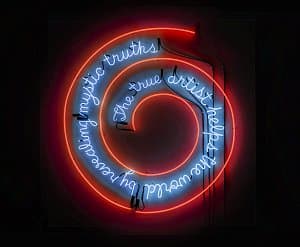

Bruce Nauman
Learn moreThe true artist helps the world by revealing mystic truths (Window or wall sign) 1967
© Bruce Nauman. ARS/Copyright Agency Purchased 1978
More detail | PermalinkThe true artist helps the world by revealing mystic truths (Window or wall sign) was made in the winter of 1966–67 at a time when Bruce Nauman had established his studio in a disused grocery store in San Francisco. The work was designed for a large shop window at the front of the studio, rather like the neon advertising signs that hung in the shopfronts nearby, although with quite a different message.[1] Referring to the conception of Window or wall sign, Nauman stated:
I had the idea that I could make art that would kind of disappear—an art that was supposed to not quite look like art. In that case, you wouldn’t really notice it until you paid attention. Then, when you read it, you would have to think about it ... The most difficult thing about the whole piece for me was the statement. It was a kind of test—like when you say something out loud to see if you believe it. Once written down, I could see that the statement, ‘The true artist helps the world by revealing mystic truths’ was on the one hand a totally silly idea and yet, on the other hand, I believed it. It’s true and it’s not true at the same time. It depends on how you interpret it and how seriously you take yourself. For me it’s still a very strong thought.[2]
Nauman’s use of neon, a commercially-produced, non-art material associated with motels, bars or advertising, seems to counteract his lofty statement. The dualism of his ideas is enhanced by the colour, form and structure of the work. At a distance the red spiral reads as the number six while the dense, more elaborate blue lettering provides a counterpoint: the strength of the numeric graphic sign is thrown into relief by the twists, turns and rhythm of the cursive shapes. Moreover, the message and promise to reveal ‘mystic truths’ is likewise complemented by the spiral form, a symbol often interpreted as the notion of journey, growth and evolution. Indeed, Joan Simon has linked Nauman’s interest in solving or revealing ‘impossible’ problems to his training as a mathematician.[3] Elsewhere, such as Eleven color photographs 1966–67 (see p xx) he composes images that undermine the idea of words as a means of communication, treating ‘linguistic fragments and material issues as interchangeable’.[4]
The success of Nauman’s first New York exhibition at Leo Castelli Gallery in early 1968 prompted Castelli to suggest that works by the artist using fluorescent tubing should be issued in small editions; Nauman authorised Window or wall sign to be produced in an edition of three.[5] The idea that an artist should advertise or promote his ability to see beyond everyday matters, and then distribute ‘evidence’ of this faculty in the form of an elegantly scripted, coloured sign seems at once self-evident and wryly humorous. Nauman continued to work with text and neon, most intensely in the 1980s, and Window or wall sign remains one of his most enduring and influential works.
Lucina Ward[6]
[1] At this time Nauman produced a transparent Mylar window shade imprinted ‘The true artist is an amazing luminous fountain’, which also appeared behind the plate‑glass window of the shopfront. Location?
[2] Brenda Richardson, Bruce Nauman: Neons, Baltimore Museum of Art, Maryland, 1982, p 20.
[3] Joan Simon, ‘Breaking the silence: An interview with Bruce Nauman, 1988 (January, 1987)’, in Janet Kraynak (ed), Please pay attention please: Bruce Nauman’s words: Writings and interviews, MIT Press, Cambridge, Massachusetts, 2005, pp 317–38, at p 323.
[4] As above, p 317.
[5] Others from the edition are in the Rijksmuseum Kröller‑Müller, Otterlo; Museum für Gegenwartskunst, Basel; and Philadelphia Museum of Art.
[6] Adapted and updated from Michael Lloyd and Michael Desmond, European and American Paintings and Sculptures 1870–1970 in the Australian National Gallery, Australian National Gallery, Canberra, 1992, p 372.

